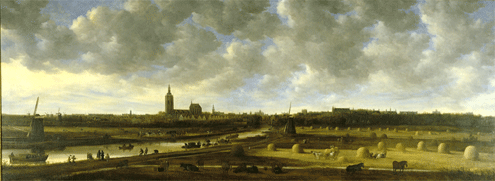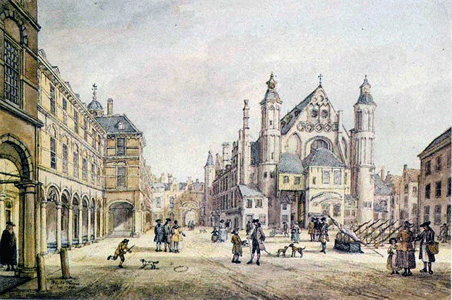A short history of The Hague
The Hague is a city of international importance with many faces, home to many different cultures. Once little more than a country house near a pond, The Hague has developed into a city of international character and importance, a never-ending story: a little bit of history is added every day.

The Counts’ Hedge
Though officially called Den Haag, the locals often refer to it as ‘s-Gravenhage, literally: ‘The Counts’ Hedge’. The Counts of Holland enjoyed hunting and took special interest in the area’s vast forests that reached from Gravenzande to Leiden in the Middle Ages, the remains of which are now known as the Haagse Bos. Originally basing themselves near the pond now known as the Hofvijver in the centre of The Hague, in the 13th century Count Willem II built the Binnenhof, or current houses of parliament, on the same spot. Lacking city rights, The Hague was unable to build the traditional wall and moat system of the day, so a town hall was built which can still be seen today in the Groenmarkt.
The keys to the city
The Hague is first chartered as a village called Die Haghe, until Louis Napoleon, King of the Netherlands from 1806, took entry. He insisted that by the following day he ‘be offered the keys of the city at a ceremony in The Hague.’ Without walls, or even a gate, the city couldn’t offer much in the line of actual keys. In some haste the elders asked the silversmith François Simons to produce 2 gilded silver keys which were offered to the king on an embroidered cushion. A few months later Napoleon proclaimed The Hague ‘third city of the kingdom’.
The birth of a reputation
By 1851 local legislation no longer distinguished cities from villages and they all became municipalities, or gemeenten, with The Hague as the Royal Residence and Amsterdam as the capital. As a government town and seat of the monarchy, The Hague attracted many embassies and began its reputation as an international city.
The Royal Residence was not walled. In full view of its surroundings it rose proudly from the fields, water and dunes. Vulnerable but hospitable, the city welcomed all visitors who arrived by canal boat, stagecoach or ship, and the town grew gradually until the Industrial Revolution, when growth exploded. Suddenly The Hague attracted migrants from near and far, overcrowding the town and forcing development to continue outside the original city centre, an area known aptly enough as The Hague New Centre.

The 20th century
The 20th century saw The Hague’s coming of age as an international city of peace and justice. In 1899 hundreds of delegates from 26 countries gathered for 3 months at Huis ten Bosch for the First Peace Conference. An effort to set standards for conflict resolution between nations, it gave birth to the Permanent Court of Arbitration and was followed by an even larger Second Peace Conference in The Hague in 1907.
The Third Hague Peace Conference, planned for 1915, was usurped by the First World War, but 4 years of trench warfare did their work and the Conference’s ideals were institutionalised in a Permanent Meeting of the League of Nations in Switzerland. In The Hague the ideals took actual form: the world-famous Peace Palace, financed by Andrew Carnegie, was officially opened in 1913 on the eve of the First World War. Home to the Permanent Court of Arbitration, it welcomed the Permanent Court of International Justice (under the League of Nations) in 1922 and is now the seat of its successor, the International Court of Justice, the principal judicial organ of the United Nations.
The international reputation of The Hague continues to develop. The city centre still features the ancient buildings where its history was forged, with world-class, modern architecture sprouting like exotic flowers around, and the international organisations in the International Zone continue to expand in both reach and number. The UN Security Council established the Yugoslavia Tribunal in 1993 to try individuals for genocide, war crimes and crimes against humanity committed in the former Yugoslavia. The International Criminal Court was established in The Hague in 2002, and the OPCW and many other organisations make their home here.
With over 100 ethnic groups living side by side, The Hague has embraced its heritage and strives to be deserving of the title ‘International City of Peace and Justice’.
Interesting facts
- The Hague is the third largest city of the Netherlands with a population of over 500,000.
- The Hague has traditionally been a city of storks, thus the stork on the coat of arms and as the logo of the municipality. In the Middle Ages they were domesticated to remove fish remains at the fish market and nested on the buildings around the Binnenhof and in the area of the Groenmarkt and were seen as bringers of luck and prosperity.
- In 1456 the Thirty Knights of the Mighty Order of the Gulden Vlies (Golden Fleece) came to The Hague for their first meeting in full armour, some on horseback and many on foot. The Knights had their meeting in the Hall of Knights, or Ridderzaal, and at the Grote Kerk (Big Church) where you can still see remnants of their weaponry.
- The greenery in The Hague has always been protected. In the early Middle Ages by the Counts of Holland and, from the 14th century onwards, by forest wardens and citizens alike. They were supported by the 1576 Act of Redemption, a law banning the felling or selling of trees.

Famous visitors
- Tsar Peter the Great of Russia tried to visit The Hague incognito in 1697 to meet ordinary people, but at 2 metres (in those days the average Dutchman was about 1.65 metres) he was quickly found out. In 1717 he returned to The Hague openly and received a royal welcome.
- The Italian adventurer Giacomo Casanova visited The Hague in 1759 and fought a duel on the Malieveld. His attentions naturally turned to the fairer sex during his visit and in his memoirs he wrote that one of them had such an extreme beauty that ‘it set my blood on fire’.
- Other famous visitors or residents have included: Van Gogh, Descartes, Spinoza, Erasmus, Hugo Grotius and Mozart.
Landmark hotels
- The monument building Hotel Des Indes was built as the city residence of Baron van Brienen, also owner of the country estate Clingendael. A hotel since 1881, many celebrities have stayed there: South African President Paul Kruger, the Russian Ballerina Anna Pavlova, Sir Winston Churchill and the musician Prince, to name a few.
- The coming of the Kurhaus Hotel represents the beginning of international tourism in Scheveningen. The history of the Kurhaus begins in 1818 when Jacob Pronk, an enterprising local, decided to build a pavilion in which 4 rooms were equipped with baths. In 1886, the Kurhaus burned to the ground and was rebuilt within a year to its now rather grander stature.
UN and EU
- As home to the International Court of Justice, The Hague is the only city outside of New York with a UN main body and is a homebase to nearly every international organisation in the field of peaceful administration.
- In 1998 former UN Secretary-General Boutros Boutros-Ghali, described The Hague as ‘the legal capital of the world’.
- With important international organisations like Europol and Eurojust, The Hague is also a European city. In 1948 the former British Prime Minister Sir Winston Churchill spoke in The Hague about European unity, ‘It is indeed fitting that this first Congress of Europe should meet in Holland which, with her neighbours in the Benelux group, is already leading the way by her example…’ At the time The New York Times observed, ‘We are witnessing today in The Hague a phenomenon of the greatest importance: we are witnessing the renewal of the European spirit.’
Haagse hopje
At the end of the 18th century, Hendrik Hop left his cup of coffee by the fire, returning the next morning to find it completely solid. Cautiously Hop tasted some: it was delicious! He asked his baker to make some small sweet chunks with the same flavour and the Haagse Hopje was born. In the past, this specialty was particularly popular with the higher classes, but now they’re part of the culture.
Haagse Jantje
Every Dutch child knows a lullaby about the Haagse Jantje, translated here:
In The Hague there lives a Count
And his son is called Jantje
If you ask: ‘Where does your daddy live?’
He’ll show you with his hand-tje
With his finger and his thumb
On his hat he wears a feather
On his arm’s a basket
Bye, my sweet Jantje!
Count Floris V is the count in the song, and, in addition to having a son named Jantje, he completed the construction of the Knight’s Hall, or Ridderzaal, in the count’s castle in the 13th century. Sadly Jantje died at the age of 13, but across from the Mauritshuis a statue of a little boy points to the roof of the Knight’s Hall.
